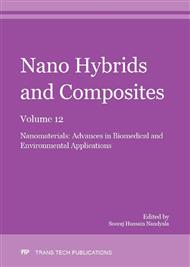[1]
S. Mornet, S. Vasseur, F. Grasset, E. Duguet, Magnetic nanoparticle design for medical diagnosis and therapy, J. Mat. Chem. 14 (2004) 2161–2175.
DOI: 10.1039/b402025a
Google Scholar
[2]
F. Sonvico, C. Dubernet, P. Colombo, P. Couvreur, Metallic colloid nanotechnology, applications in diagnosis and therapeutics, Curr. Pharm. Des. 11 (2005) 2091–2105.
DOI: 10.2174/1381612054065738
Google Scholar
[3]
F.C. Meldrum, V.J. Wade, D.L. Nimmo, B.R. Heywood, S. Mann, Synthesis of inorganic nanophase materials in supramolecular protein cages, Nature 349 (1991) 684-687.
DOI: 10.1038/349684a0
Google Scholar
[4]
T. Douglas, D.P.E. Dickson, S. Betteridge, J. Charnock, C.D. Garner, S. Mann, Synthesis and Structure of an Iron(III) Sulfide-Ferritin Bioinorganic Nanocomposite, Science 269 (1995) 54-57.
DOI: 10.1126/science.269.5220.54
Google Scholar
[5]
T. Douglas, M. Young, Host–guest encapsulation of materials by assembled virus protein cages, Nature 393 (1998) 152-155.
DOI: 10.1038/30211
Google Scholar
[6]
M. Knez, M. Sumser, A.M. Bittner, C. Wege, H. Jeske, T.P. Martin, K. Kern, Spatially selective nucleation of metal clusters on the Tobacco Mosaic Virus, Adv. Funct. Mater. 14 (2004) 116-124.
DOI: 10.1002/adfm.200304376
Google Scholar
[7]
E. Dujardin, C. Peet, G. Stubbs, J.N. Culver, S. Mann, Organization of metallic nanoparticles using Tobacco Mosaic Virus templates, Nano Lett. 3 (2003) 413-417.
DOI: 10.1021/nl034004o
Google Scholar
[8]
W. Shenton, S. Mann, H. Colfen, A. Bacher, M. Fischer, Synthesis of nanophase iron oxide in Lumazine Synthase Capsids, Angew. Chem. 113 (2001) 456-459; Angew. Chem. Int. Ed. 40 (2001) 442-445.
DOI: 10.1002/1521-3773(20010119)40:2<442::aid-anie442>3.0.co;2-2
Google Scholar
[9]
D. Ishii, K. Kinbara, Y. Ishida, N. Ishii, M. Okochi, M. Yohda, T. Aida, Chaperonin-mediated stabilization and ATP-triggered release of semiconductor nanoparticles, Nature 423 (2003) 628-632.
DOI: 10.1038/nature01663
Google Scholar
[10]
P.M. Harrison, P. Arosio, The ferritins: Molecular properties, iron storage function and cellular regulation, Biochim. Biophys. Acta 1275 (1996) 161-203.
DOI: 10.1016/0005-2728(96)00022-9
Google Scholar
[11]
M. Ceolín, N. Gálvez, P. Sánchez, B. Fernández, J.M. Domínguez-Vera, Structural aspects of the growth mechanism of Copper nanoparticles inside apoferritin, Eur. J. Inorg. Chem. 2008 (2008) 795–801.
DOI: 10.1002/ejic.200700891
Google Scholar
[12]
J.D. Klemm, S.L. Schreiber, G.R. Crabtree, Dimerization as a regulatory mechanism in signal transduction, Annu. Rev. Immunol. 16 (1998) 569–592.
DOI: 10.1146/annurev.immunol.16.1.569
Google Scholar
[13]
A. Fegan, B. White, J.C.T. Carlson, C.R. Wagner, Chemically controlled protein assembly: Techniques and applications, Chem. Rev. 110 (2010) 3315–3336.
DOI: 10.1021/cr8002888
Google Scholar
[14]
T.W. Corson, N. Aberle, C.M. Crews, Design and applications of bifunctional small molecules: Why two heads are better than one, ACS Chem. Biol. 3 (2008) 677–692.
DOI: 10.1021/cb8001792
Google Scholar
[15]
F.C. Meldrum, B.R. Heywood, S. Mann, Magnetoferritin: In vitro synthesis of a novel magnetic protein, Science 257 (1992) 522-523.
DOI: 10.1126/science.1636086
Google Scholar
[16]
G. Liu, H. Wu, J. Wang, Y. Lin, Apoferritin-templated synthesis of metal phosphate nanoparticle labels for electrochemical immunoassay, Small 2 (2006) 1139-1143.
DOI: 10.1002/smll.200600206
Google Scholar
[17]
T. Douglas, V.T. Stark, Nanophase Cobalt oxyhydroxide mineral synthesized within the protein cage of Ferritin, Inorg. Chem. 39 (2000) 1828-1830.
DOI: 10.1021/ic991269q
Google Scholar
[18]
J. -W. Kim, S.H. Choi, P.T. Lillehei, S. -H. Chu, G.C. King, G.D. Watt, Cobalt oxide hollow nanoparticles derived by bio-templating, Chem. Commun. (2005) 4101-4103.
DOI: 10.1039/b505097a
Google Scholar
[19]
R.M. Kramer, C. Li, D.C. Carter, M.O. Stone, R.R. Naik, Engineered protein cages for nanomaterial synthesis, J. Am. Chem. Soc. 126 (2004) 13282-13286.
DOI: 10.1021/ja046735b
Google Scholar
[20]
T. Ueno, M. Suzuki, T. Goto, T. Matsumoto, K. Nagayama, Y. Watanabe, Size-selective Olefin hydrogenation by a Pd nanocluster provided in an Apoferritin cage, Angew. Chem. 116 (2004) 2581-2584; Angew. Chem. Int. Ed. 43 (2004) 2527-2530.
DOI: 10.1002/anie.200353436
Google Scholar
[21]
B. Warne, O.I. Kasyutich, E.L. Mayes, J.A.L. Wiggins, K.K.W. Wong, Self assembled nanoparticulate Co: Pt for data storage applications, IEEE Trans. Magn. 36 (2000) 3009-3011.
DOI: 10.1109/20.908658
Google Scholar
[22]
R. Chiaraluce, V. Consalvi, S. Cavallo, A. Ilari, S. Stefanini, E. Chiancone, The unusual dodecameric ferritin from Listeria innocua dissociates below pH 2. 0, Eur. J. Biochem. 267 (2000) 5733-5741.
DOI: 10.1046/j.1432-1327.2000.01639.x
Google Scholar
[23]
J. Maheshkumar, B. Sreedhar, B.U. Nair, A. Dhathathreyan, Supported lipid bilayers as templates to design manganese oxide nanoparticles, J. Chem. Sci. 124 (2012) 979-984.
DOI: 10.1007/s12039-012-0295-4
Google Scholar
[24]
L. Whitemore, B. Wallace, DICHROWEB, an online server for protein secondary structure analyses from circular dichroism spectroscopic data, Nucleic Acids Res. 32 (2004) W668−673.
DOI: 10.1093/nar/gkh371
Google Scholar
[25]
J.G. Wardeska, B. Viglione, N.D. Chasteen, Metal ion complexes of apoferritin, J. Biol. Chem. 261 (1986) 6677-6683.
DOI: 10.1016/s0021-9258(19)62670-0
Google Scholar
[26]
C. Jordan, K.M. Bennett, High R1 of Mn2+ adsorbed to hydrophilic pores of magnetoferritin nanoparticles, Proc. Intl. Soc. Mag. Reson. Med. 19 (2011) 321.
Google Scholar


